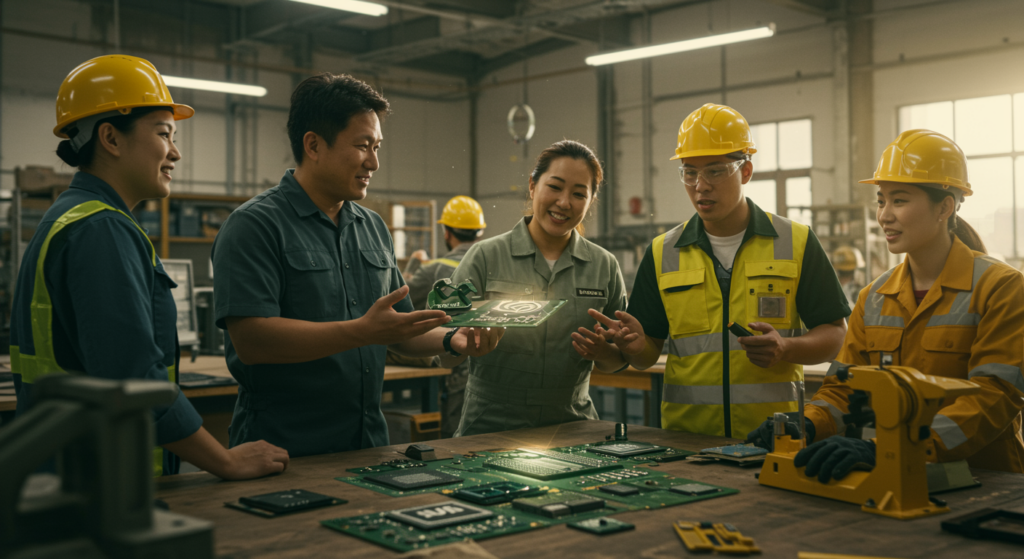
AI Arms Race: NVIDIA CEO Stresses Need for Trades People and Engineers
Understanding the AI Arms Race
The AI arms race is heating up as companies, governments, and researchers race to deploy advanced artificial intelligence technologies that reshape everything from healthcare to transportation. This competitive push brings groundbreaking opportunities, but it also exposes gaps in the workforce that could slow progress. NVIDIA CEO Jensen Huang has been vocal about this, stressing that skilled tradespeople and engineers are the backbone of sustained innovation.
Imagine a world where AI systems power smart cities, autonomous factories, and personalized medicine—it’s exhilarating, yet it demands a human touch to build and maintain these systems. According to Huang, the real challenge isn’t just developing smarter algorithms; it’s about having enough trained professionals to turn ideas into reality in this AI arms race.
Have you ever wondered how your daily tech relies on unseen experts? From electricians wiring AI-enabled robots to engineers designing efficient data centers, their roles are crucial. This human element ensures that the AI arms race doesn’t falter due to a shortage of practical skills.
Jensen Huang’s Perspective: The Human Factor in the AI Arms Race
In a recent keynote at GTC 2025, NVIDIA CEO Jensen Huang painted a vivid picture of the AI arms race, emphasizing that technology alone won’t win the day—people will. He shared how AI is evolving rapidly, turning ambitious visions into everyday tools, but warned that we need more than coders; we require hands-on experts like tradespeople and engineers.
Huang’s words resonate deeply: “AI is pushing the limits of what’s possible—turning yesterday’s dreams into today’s reality… The brightest scientists, engineers, developers, and creators are coming together to imagine and build a better future.” This quote, from his address, underscores the collaborative spirit needed. It’s not just about big tech; it’s about empowering a diverse workforce to keep the AI arms race moving forward.
What if we viewed the AI arms race as a team sport? Huang does, urging investment in roles that bridge the gap between high-level AI research and real-world application. By prioritizing these human factors, industries can avoid bottlenecks and foster sustainable growth.
The Growing Demand for Skilled Tradespeople in the AI Arms Race
As the AI arms race accelerates, skilled tradespeople are emerging as unsung heroes, handling the nuts and bolts of AI implementation. Technicians and electricians, for instance, are essential for installing and repairing AI-powered equipment in factories and infrastructure projects. Their expertise ensures that automation runs smoothly, preventing costly downtimes.
Consider a hypothetical scenario: A manufacturing plant adopts AI-driven robots to boost efficiency, but without on-site tradespeople to maintain them, the system could grind to a halt. That’s why roles like machine operators and system integrators are in high demand, supporting tasks from rapid prototyping to on-site troubleshooting. In the AI arms race, these professionals make innovation practical and accessible.
Actionable tip: If you’re in a trade, think about upskilling in AI basics—courses on robotics maintenance could open doors to high-demand jobs. How might this shift impact your career path?
Engineers: Key Players in Fueling the AI Arms Race
Engineers stand at the forefront of the AI arms race, architecting the hardware and systems that power cutting-edge technologies. From designing NVIDIA’s high-performance chips to building energy-efficient data centers, their work ensures AI can scale without overwhelming resources. This includes integrating AI models into applications like robotics, where reliability is non-negotiable.
These experts handle everything from cloud computing platforms to sustainable architectures that reduce environmental impact. For example, engineers are vital in developing AI supercomputers that support research in climate modeling or drug discovery. In the midst of the AI arms race, their innovations keep us competitive and forward-thinking.
Relatable example: Picture an engineer refining AI chips for autonomous vehicles—what they do today could make tomorrow’s roads safer. If you’re passionate about tech, exploring engineering fields might be your entry into this dynamic race.
How AI Is Reshaping the Workforce Amid the AI Arms Race
The AI arms race is transforming job landscapes, creating a surge in demand for workers who can blend traditional skills with modern AI tools. Engineers and tradespeople are adapting to oversee AI integration in manufacturing, where they maintain robotic systems and troubleshoot issues in real time. This evolution isn’t about replacement; it’s about enhancement, with AI amplifying human capabilities.
Taking autonomous vehicles as an example, technicians ensure these systems are deployed safely, while engineers upgrade software and hardware. Similarly, in expanding cloud infrastructures, human oversight prevents failures and optimizes performance. Have you considered how the AI arms race might change the skills needed in your industry?
Practical advice: Start by identifying AI trends in your field—perhaps attending workshops on AI ethics or hardware integration. This proactive approach can help you thrive in the AI arms race.
The Role of Education and Upskilling in the AI Arms Race
To keep pace with the AI arms race, education must evolve, focusing on STEM programs that emphasize hands-on AI and engineering skills. Universities and vocational schools are stepping up with apprenticeships, internships, and specialized courses in chip design and robotics. These initiatives bridge the talent gap, preparing tradespeople and engineers for tomorrow’s challenges.
For instance, collaborations between NVIDIA and educational institutions provide access to state-of-the-art tools, allowing students to gain practical experience. Continuous learning is key—think online certifications in AI infrastructure or workshops on sustainable computing. What steps can you take to stay ahead in this fast-paced race?
Here’s a quick strategy: Dedicate time each week to learning platforms like Coursera or NVIDIA’s own resources. By doing so, you’re not just keeping up; you’re positioning yourself as a vital player in the AI arms race.
The Symbiosis Between AI and the Human Workforce in Today’s AI Arms Race
The AI arms race thrives on a symbiotic relationship between technology and people, as seen in NVIDIA’s open-source projects like Project Digits. These efforts democratize AI access, enabling students and professionals to experiment with advanced tools that were once exclusive. This approach empowers a wider workforce, from startups to large firms, to innovate effectively.
By making AI supercomputers more available, initiatives like this ensure that tradespeople and engineers can shape the technology, not just use it. It’s a cycle of growth: Human expertise drives AI advancements, which in turn create more opportunities. In the AI arms race, this partnership is what turns potential into progress.
A brief anecdote: I recall hearing from a young engineer who used NVIDIA’s platforms to prototype a new AI device—now, that’s the kind of story that inspires real change. How could you leverage similar resources?
Key Takeaways: Navigating the Future of the AI Arms Race
In the AI arms race, the focus on skilled tradespeople and engineers isn’t optional—it’s essential for building and sustaining AI infrastructure. Investments in education and training are paying off, helping to meet industry demands and foster innovation. Leaders like NVIDIA are leading the charge through partnerships and accessible technologies.
Remember, this race is about balance: AI needs human ingenuity to reach its full potential. By prioritizing upskilling and collaboration, we can create a workforce that’s ready for whatever comes next. What’s one action you’ll take based on these insights?
- The AI arms race relies on diverse talent to implement and maintain technologies.
- Upskilling programs are crucial for adapting to rapid changes.
- Open platforms from companies like NVIDIA are democratizing access to tools.
Conclusion: Building a Sustainable AI Future Together
The AI arms race can’t succeed on technology alone; it needs the dedication of skilled tradespeople and engineers to bring visions to life. Visionaries like Jensen Huang remind us to invest in both digital and human resources for a balanced approach. As we move forward, let’s commit to education and innovation that ensures AI drives positive change.
This is your invitation: Share your thoughts in the comments below—how is the AI arms race impacting your work? Explore more on our site, like related posts on AI ethics, and let’s keep the conversation going.
References
- NVIDIA CEO Jensen Huang’s Keynote at GTC 2025. Source
- NVIDIA’s CES 2025 Announcements. Source
- Other related sources: Instagram post from CNBC Make It (Link), NVIDIA CES Event (Link), YouTube videos (Link and Link), and ITU Journal (Link).
AI arms race, NVIDIA CEO, Jensen Huang, skilled tradespeople, engineering workforce, AI technology, AI innovation, workforce upskilling, AI infrastructure, human expertise







